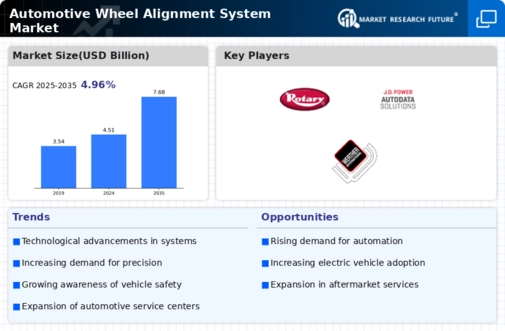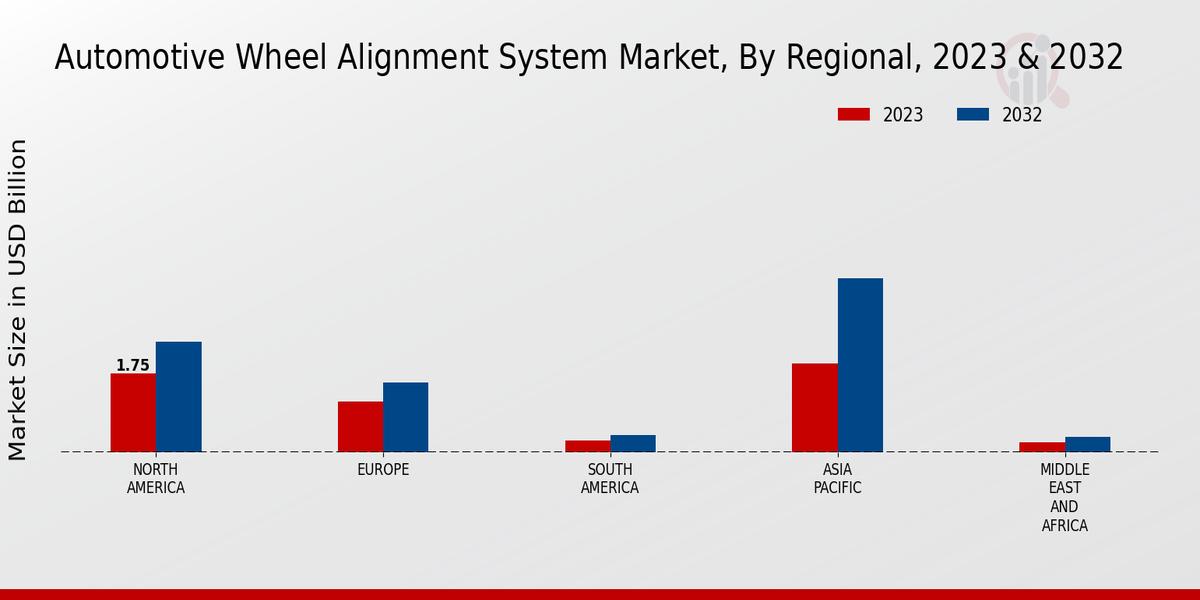Market Growth Projections
The Global Automotive Wheel Alignment System Market Industry is projected to experience substantial growth over the coming years. With a market valuation of 4.51 USD Billion in 2024, the industry is expected to expand at a CAGR of 4.96% from 2025 to 2035, reaching an estimated 7.68 USD Billion by 2035. This growth trajectory indicates a robust demand for wheel alignment systems, driven by factors such as increasing vehicle production, technological advancements, and heightened consumer awareness. The market's expansion reflects the critical role that wheel alignment plays in vehicle performance and safety.
Technological Advancements
Technological innovations in the automotive sector are significantly influencing the Global Automotive Wheel Alignment System Market Industry. Advanced alignment systems, incorporating laser technology and computer diagnostics, enhance precision and efficiency. These systems not only improve the accuracy of alignments but also reduce the time required for service. As vehicles become more sophisticated, the demand for high-tech alignment solutions is likely to rise. This trend aligns with the projected growth of the market, which is expected to reach 7.68 USD Billion by 2035. The integration of technology into wheel alignment systems is essential for meeting the evolving needs of modern vehicles.
Increasing Vehicle Production
The Global Automotive Wheel Alignment System Market Industry is poised for growth due to the rising production of vehicles worldwide. As manufacturers ramp up output to meet consumer demand, the need for efficient wheel alignment systems becomes paramount. In 2024, the market is valued at 4.51 USD Billion, reflecting the industry's response to increased vehicle assembly. This trend is expected to continue, with projections indicating a market size of 7.68 USD Billion by 2035. The compound annual growth rate (CAGR) of 4.96% from 2025 to 2035 underscores the importance of wheel alignment systems in maintaining vehicle performance and safety.
Expansion of Automotive Aftermarket
The expansion of the automotive aftermarket is a crucial driver for the Global Automotive Wheel Alignment System Market Industry. As more vehicles age and require maintenance, the demand for aftermarket services, including wheel alignment, is expected to grow. This trend is supported by the increasing number of vehicles on the road, which creates a larger customer base for alignment services. The market is projected to grow from 4.51 USD Billion in 2024 to 7.68 USD Billion by 2035, indicating a robust opportunity for aftermarket service providers. The growth of this sector is likely to enhance the overall demand for advanced wheel alignment systems.
Growing Awareness of Vehicle Maintenance
There is a notable increase in consumer awareness regarding vehicle maintenance, which is positively impacting the Global Automotive Wheel Alignment System Market Industry. As drivers become more informed about the benefits of regular wheel alignment, including improved fuel efficiency and tire longevity, the demand for alignment services is likely to rise. This heightened awareness is expected to contribute to the market's growth, with a valuation of 4.51 USD Billion in 2024. The trend suggests that consumers are prioritizing vehicle upkeep, which could lead to a sustained demand for wheel alignment systems as part of routine maintenance.
Regulatory Standards and Safety Regulations
Regulatory standards and safety regulations are increasingly influencing the Global Automotive Wheel Alignment System Market Industry. Governments worldwide are implementing stricter safety standards for vehicles, which often include requirements for proper wheel alignment. Compliance with these regulations necessitates the use of advanced alignment systems, driving demand in the market. As safety becomes a priority for manufacturers and consumers alike, the market is expected to grow significantly, with projections indicating a rise from 4.51 USD Billion in 2024 to 7.68 USD Billion by 2035. This regulatory landscape is likely to shape the future of wheel alignment systems.















Leave a Comment